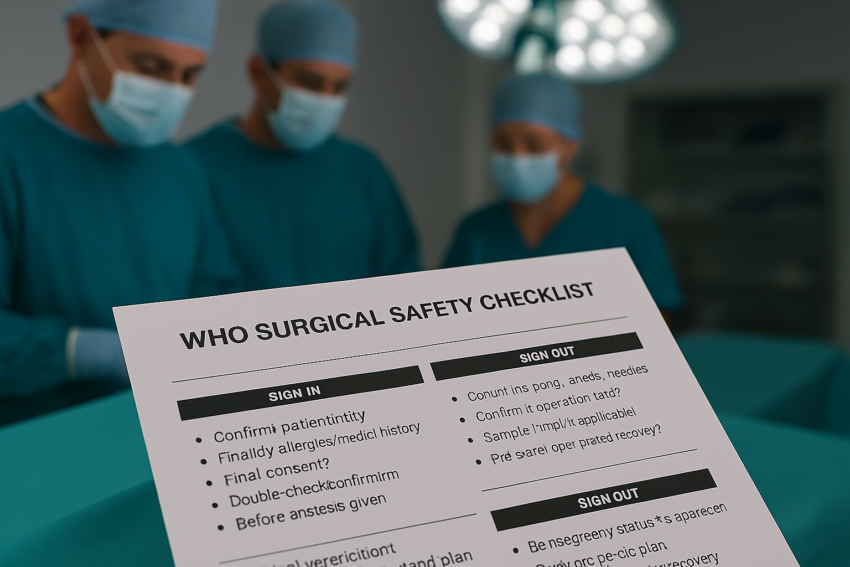Table of Contents
I still remember the first time I stepped into an operating room as a nurse. The sterile smell, the hum of monitors, the quiet focus of the team—it was a world of precision, discipline, and unwavering responsibility. It was also a world where mistakes simply couldn’t happen, because when lives are at stake, safety isn’t just important—it’s everything.
One of the most critical tools we use to ensure patient safety is the WHO Surgical Safety Checklist. It might seem simple—a structured list of steps to follow—but let me tell you, this checklist has saved lives. It’s not just another protocol; it’s the backbone of how we make sure every surgery goes right.
What Happens Before Surgery: The First Line of Defense
Before any patient is wheeled into the OR, we start with Sign In—the first phase of the Surgical Safety Checklist. This is where we stop and confirm everything:
🔹 Patient identity – You’d be surprised how easy it is for mix-ups to happen, especially in a busy hospital. I once had two patients with nearly identical names scheduled for surgery on the same day. Without this step, we could have prepped the wrong one.
🔹 Allergies and medical history – I’ve seen cases where a patient had an unknown allergy to anesthesia—catching that beforehand prevents serious complications.
🔹 Necessary equipment – Ever had a missing surgical instrument mid-procedure? You don’t want that. We double-check that everything is available before anesthesia is given.
This part of the Surgical Safety Checklist might feel like overkill sometimes, but trust me, every detail matters.
Time Out: The Moment That Saves Lives
One of the most critical steps happens just before the surgeon makes the first incision. This is the Time Out phase of the Surgical Safety Checklist. Everything stops. Everyone—surgeons, anesthetists, nurses, techs—takes a moment to double-check key details:
🔹 Are we about to operate on the correct body part?
🔹 Does everyone understand the plan?
🔹 Are there any concerns before we begin?
I once had a moment during Time Out where I caught a mistake seconds before the first incision. The procedure was on a patient’s left side, but the draping had been positioned for the right. If I hadn’t spoken up, we could have started on the wrong side. That pause saved the patient from an unnecessary, devastating error.
There’s a reason why we take this moment seriously—because it works.
Sign Out: Wrapping Up Safely
After the surgery is done, we move into the Sign Out phase of the Surgical Safety Checklist. This is where nurses, including me, become hyper-focused on one thing: ensuring nothing gets left behind.
🔹 Instrument counts – Every scalpel, sponge, needle—everything is accounted for.
🔹 Final verification – We confirm the procedure was performed correctly and review post-op care details.
🔹 Patient readiness – Is the patient stable? Are they ready for recovery?
There’s a deep sense of responsibility here. I’ve stayed behind in the OR, double-checking and recounting instruments just to be absolutely sure nothing was missed. If something is wrong, we fix it before the patient leaves the room.
Why the Surgical Safety Checklist Matters—For Nurses and Patients
The WHO Surgical Safety Checklist isn’t just paperwork—it’s a lifeline. Without it, the operating room would be full of assumptions, rushed decisions, and avoidable mistakes. As a nurse, I see firsthand how much difference this simple list makes:
✅ It prevents errors – Catching mistakes before they happen is better than fixing them afterward.
✅ It encourages teamwork – The checklist gives every OR staff member the chance to speak up.
✅ It reassures patients – Knowing there’s a structured process puts people at ease before surgery.
More than anything, this Surgical Safety Checklist is about empowering nurses to be advocates for patient safety. Because sometimes, it’s the nurse who notices a mistake before anyone else does. Sometimes, it’s the nurse who speaks up when something feels off. And sometimes, that one moment can change everything for a patient.
Why I Trust the Surgical Safety Checklist
I’ve worked long enough in the OR to know that mistakes happen, even to the most experienced teams. The key isn’t pretending that we’ll never make errors—it’s making sure we have systems in place to catch them before they happen.
That’s why I trust the WHO Surgical Safety Checklist.
As a nurse, it’s comforting to know that no matter how intense, complicated, or urgent a surgery is, we always stop, double-check, and communicate. I know that if I speak up, my team will listen. I know that if something doesn’t feel right, we pause and fix it.
And in the end, that’s what keeps our patients safe. Because safety isn’t just a protocol—it’s a promise.
SUBSCRIBE TO MY NEWSLETTER
Want to hear more real stories from the OR, insights on nursing, and tips on patient safety? Subscribe to our newsletter!
For more insights into the daily work of an operating room nurse or the challenges faced in surgery, explore our posts on Navigating Your First Year in Nursing and Sterility Matters: Why Theatre Nurses Are Essential in the OperatingTheatre.
You can find more details about the WHO Surgical Safety Checklist on their official page here
.
SUBSCRIBE TO MY YOUTUBE
🎥 Want to see what nursing looks like beyond the written word? Join me on YouTube
where I dive deeper into topics like surgical safety, emotional wellness, and real behind-the-scenes moments from a nurse’s perspective. Subscribe todayand be part of a growing community that empowers caregivers and celebrates the heart of healthcare.
